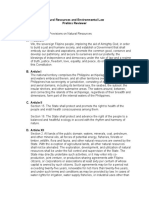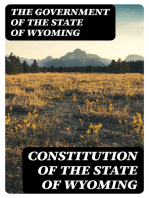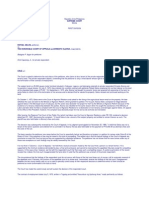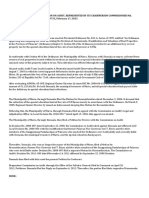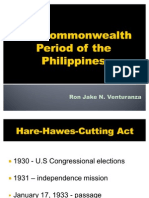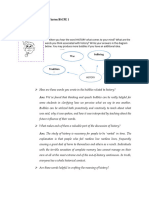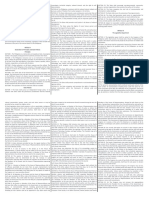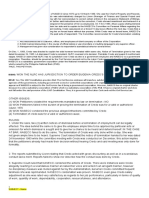Regalian Doctrine
Regalian Doctrine
Uploaded by
Ana AdolfoCopyright:
Available Formats
Regalian Doctrine
Regalian Doctrine
Uploaded by
Ana AdolfoOriginal Description:
Copyright
Available Formats
Share this document
Did you find this document useful?
Is this content inappropriate?
Copyright:
Available Formats
Regalian Doctrine
Regalian Doctrine
Uploaded by
Ana AdolfoCopyright:
Available Formats
THE CONCEPT OF JURE REGALIA -REGALIAN DOCTRINE Details Category: Land Titles And Deeds
WHAT IS THE CONCEPT OF JURE REGALIA? (REGALIAN DOCTRINE) > Generally, under this concept, private title to land must be traced to some grant, express or implied, from the Spanish Crown or its successors, the American Colonial Government, and thereafter, the Philippine Republic > In a broad sense, the term refers to royal rights, or those rights to which the King has by virtue of his prerogatives > The theory of jure regalia was therefore nothing more than a natural fruit of conquest CONNECTED TO THIS IS THE STATES POWER OF DOMINUUM > Capacity of the state to own or acquire propertyfoundation for the early Spanish decree embracing the feudal theory of jura regalia > This concept was first introduced through the Laws of the Indies and the Royal Cedulas > The Philippines passed to Spain by virtue of discovery and conquest. Consequently, all lands became the exclusive patrimony and dominion of the Spanish Crown. > The Law of the Indies was followed by the Ley Hipotecaria or the Mortgage Law of 1893. This law provided for the systematic registration of titles and deeds as well as possessory claims
> The Maura Law: was partly an amendment and was the last Spanish land law promulgated in the Philippines, which required the adjustment or registration of all agricultural lands, otherwise the lands shall revert to the State TAKE NOTE THAT THE REGALIAN DOCTRINE IS ENSHRINED IN OUR PRESENT AND PAST CONSTITUTIONS THE 1987 CONSTITUTION PROVIDES UNDER NATIONAL ECONOMY AND PATRIMONY THE FOLLOWING > Section 2. All lands of the public domain, waters, minerals, coal, petroleum, and other mineral oils, all forces of potential energy, fisheries, forests or timber, wildlife, flora and fauna, and other natural resources are owned by the State. With the exception of agricultural lands, all other natural resources shall not be alienated. The exploration, development, and utilization of natural resources shall be under the full control and supervision of the State. The State may directly undertake such activities, or it may enter into co-production, joint venture, or production-sharing agreements with Filipino citizens, or corporations or associations at least sixty per centum of whose capital is owned by such citizens. Such agreements may be for a period not exceeding twenty-five years, renewable for not more than twenty-five years, and under such terms and conditions as may be provided by law. In cases of water rights for irrigation, water supply fisheries, or industrial uses other than the development of water power, beneficial use may be the measure and limit of the grant. > The abovementioned provision provides that except for agricultural lands for public domain which alone may be alienated, forest or timber, and mineral lands, as well as all other natural resources must remain with the State, the exploration, development and utilization of which shall be subject to its full control and supervision albeit allowing it to enter into coproduction, joint venture or production-sharing agreements, or into agreements with foreign-owned corporations involving technical or financial assistance for large-scale exploration, development, and utilization
THE 1987 PROVISION HAD ITS ROOTS IN THE 1935 CONSTITUTION WHICH PROVIDES > Section 1. All agricultural timber, and mineral lands of the public domain, waters, minerals, coal, petroleum, and other mineral oils, all forces of potential energy and other natural resources of the Philippines belong to the State, and their disposition, exploitation, development, or utilization shall be limited to citizens of the Philippines or to corporations or associations at least sixty per centum of the capital of which is owned by such citizens, subject to any existing right, grant, lease, or concession at the time of the inauguration of the Government established under this Constitution. Natural resources, with the exception of public agricultural land, shall not be alienated, and no license, concession, or lease for the exploitation, development, or utilization of any of the natural resources shall be granted for a period exceeding twenty-five years, renewable for another twenty-five years, except as to water rights for irrigation, water supply, fisheries, or industrial uses other than the development of water power, in which cases beneficial use may be the measure and limit of the grant. THE 1973 CONSTITUTION REITERATED THE REGALIAN DOCTRINE AS FOLLOWS > Section 8. All lands of public domain, waters, minerals, coal, petroleum and other mineral oils, all forces of potential energy, fisheries, wildlife, and other natural resources of the Philippines belong to the State. With the exception of agricultural, industrial or commercial, residential, or resettlement lands of the public domain, natural resources shall not be alienated, and no license, concession, or lease for the exploration, or utilization of any of the natural resources shall be granted for a period exceeding twentyfive years, except as to water rights for irrigation, water supply, fisheries, or industrial uses other than development of water power, in which cases, beneficial use may by the measure and the limit of the grant. THE REGALIAN DOCTRINE DOESN'T NEGATE NATIVE TITLE. THIS IS IN PURSUANCE TO WHAT HAS BEEN HELD IN CRUZ V. SECRETARY OF ENVIRONMENT AND NATURAL RESOURCES
> Petitioners challenged the constitutionality of Indigenous Peoples Rights Act on the ground that it amounts to an unlawful deprivation of the States ownership over lands of the public domain and all other natural resources therein, by recognizing the right of ownership of ICC or IPs to their ancestral domains and ancestral lands on the basis of native title. > As the votes were equally divided, the necessary majority wasnt obtained and petition was dismissed and the laws validity was upheld > Justice Kapunan: Regalian theory doesnt negate the native title to lands held in private ownership since time immemorial, adverting to the landmark case of CARINO V. LOCAL GOVERNMENT
Regalian doctrine Regalian doctrine - All lands of the public domain belong to the State, which is the source of any asserted right to ownership of land. All lands not otherwise appearing to be clearly within private ownership are presumed to belong to the State. All lands not otherwise clearly appearing to be privately-owned are presumed to belong to the State. REGALIAN DOCTRINE But first, a peek at the Regalian principle and the power of the executive to reclassify lands of the public domain.
The 1935 Constitution classified lands of the public domain into agricultural, forest or timber.[40] Meanwhile, the 1973 Constitution provided the following divisions: agricultural, industrial or commercial, residential, resettlement, mineral, timber or forest and grazing lands, and such other classes as may be provided by law,[41] giving the government great leeway for classification.[42] Then the 1987 Constitution reverted to the 1935 Constitution classification with one addition: national parks.[43] Of these, only agricultural lands may be alienated.[44] Prior to Proclamation No. 1064 of May 22, 2006, Boracay Island had never been expressly
and administratively classified under any of these grand divisions. Boracay was an unclassified land of the public domain.
The Regalian Doctrine dictates that all lands of the public domain belong to the State, that the State is the source of any asserted right to ownership of land and charged with the conservation of such patrimony.[45] The doctrine has been consistently adopted under the 1935, 1973, and 1987 Constitutions.[46]
All lands not otherwise appearing to be clearly within private ownership are presumed to belong to the State.[47] Thus, all lands that have not been acquired from the government, either by purchase or by grant, belong to the State as part of the inalienable public domain.[48] Necessarily, it is up to the State to determine if lands of the public domain will be disposed of for private ownership. The government, as the agent of the state, is possessed of the plenary power as the persona in law to determine who shall be the favored recipients of public lands, as well as under what terms they may be granted such privilege, not excluding the placing of obstacles in the way of their exercise of what otherwise would be ordinary acts of ownership.[49]
Our present land law traces its roots to the Regalian Doctrine. Upon the Spanish conquest of the Philippines, ownership of all lands, territories and possessions in the Philippines passed to the Spanish Crown.[50] The Regalian doctrine was first introduced in the Philippines through the Laws of the Indies and the Royal Cedulas, which laid the foundation that all lands that were not acquired from the Government, either by purchase or by grant, belong to the public domain.[51]
The Laws of the Indies was followed by the Ley Hipotecaria or the Mortgage Law of 1893. The Spanish Mortgage Law provided for the systematic registration of titles and deeds as well as possessory claims.[52]
The Royal Decree of 1894 or the Maura Law[53] partly amended the Spanish Mortgage Law and the Laws of the Indies. It established possessory information as the method of legalizing possession of vacant Crown land, under certain conditions which were set forth in said decree.[54] Under Section 393 of the Maura Law, an informacion posesoria or possessory information title,[55] when duly inscribed in the Registry of Property, is converted into a title of ownership only after the lapse of twenty (20) years of uninterrupted possession which must be actual, public, and adverse,[56] from the date of its inscription.[57] However, possessory information title had to be perfected one year after the promulgation of the Maura Law, or until April 17, 1895. Otherwise, the lands would revert to the State.[58]
In sum, private ownership of land under the Spanish regime could only be founded on royal concessions which took various forms, namely: (1) titulo real or royal grant; (2) concesion especial or special grant; (3) composicion con el estado or adjustment title; (4) titulo de compra or title by purchase; and (5) informacion posesoria or possessory information title.[59]
The first law governing the disposition of public lands in the Philippines under American rule was embodied in the Philippine Bill of 1902.[60] By this law, lands of the public domain in the Philippine Islands were classified into three (3) grand divisions, to wit: agricultural, mineral, and timber or forest lands.[61] The act provided for, among others, the disposal of mineral lands by means of absolute grant (freehold system) and by lease (leasehold system).[62] It also provided the definition by exclusion of agricultural public lands.[63] Interpreting the meaning of agricultural lands under the Philippine Bill of 1902, the Court declared in Mapa v. Insular Government:[64]
x x x In other words, that the phrase agricultural land as used in Act No. 926 means those public lands acquired from Spain which are not timber or mineral lands. x x x[65] (Emphasis Ours)
On February 1, 1903, the Philippine Legislature passed Act No. 496, otherwise known as the Land Registration Act. The act established a system of registration by which recorded title becomes absolute, indefeasible, and imprescriptible. This is known as the Torrens system.[66]
Concurrently, on October 7, 1903, the Philippine Commission passed Act No. 926, which was the first Public Land Act. The Act introduced the homestead system and made provisions for judicial and administrative confirmation of imperfect titles and for the sale or lease of public lands. It permitted corporations regardless of the nationality of persons owning the controlling stock to lease or purchase lands of the public domain.[67] Under the Act, open, continuous, exclusive, and notorious possession and occupation of agricultural lands for the next ten (10) years preceding July 26, 1904 was sufficient for judicial confirmation of imperfect title.[68]
On November 29, 1919, Act No. 926 was superseded by Act No. 2874, otherwise known as the second Public Land Act. This new, more comprehensive law limited the exploitation of agricultural lands to Filipinos and Americans and citizens of other countries which gave Filipinos the same privileges. For judicial confirmation of title, possession and occupation en concepto dueo since time immemorial, or since July 26, 1894, was required.[69]
After the passage of the 1935 Constitution, CA No. 141 amended Act No. 2874 on
December 1, 1936. To this day, CA No. 141, as amended, remains as the existing general law governing the classification and disposition of lands of the public domain other than timber and mineral lands,[70] and privately owned lands which reverted to the State.[71]
Section 48(b) of CA No. 141 retained the requirement under Act No. 2874 of possession and occupation of lands of the public domain since time immemorial or since July 26, 1894. However, this provision was superseded by Republic Act (RA) No. 1942,[72] which provided for a simple thirty-year prescriptive period for judicial confirmation of imperfect title. The provision was last amended by PD No. 1073,[73] which now provides for possession and occupation of the land applied for since June 12, 1945, or earlier.[74]
The issuance of PD No. 892[75] on February 16, 1976 discontinued the use of Spanish titles as evidence in land registration proceedings.[76] Under the decree, all holders of Spanish titles or grants should apply for registration of their lands under Act No. 496 within six (6) months from the effectivity of the decree on February 16, 1976. Thereafter, the recording of all unregistered lands[77] shall be governed by Section 194 of the Revised Administrative Code, as amended by Act No. 3344.
On June 11, 1978, Act No. 496 was amended and updated by PD No. 1529, known as the Property Registration Decree. It was enacted to codify the various laws relative to registration of property.[78] It governs registration of lands under the Torrens system as well as unregistered lands, including chattel mortgages.[79]
A positive act declaring land as alienable and disposable is required. In keeping with the presumption of State ownership, the Court has time and again emphasized that there must be a positive act of the government, such as an
official proclamation,[80] declassifying inalienable public land into disposable land for agricultural or other purposes.[81] In fact, Section 8 of CA No. 141 limits alienable or disposable lands only to those lands which have been officially delimited and classified.[82]
The burden of proof in overcoming the presumption of State ownership of the lands of the public domain is on the person applying for registration (or claiming ownership), who must prove that the land subject of the application is alienable or disposable.[83] To overcome this presumption, incontrovertible evidence must be established that the land subject of the application (or claim) is alienable or disposable.[84] There must still be a positive act declaring land of the public domain as alienable and disposable. To prove that the land subject of an application for registration is alienable, the applicant must establish the existence of a positive act of the government such as a presidential proclamation or an executive order; an administrative action; investigation reports of Bureau of Lands investigators; and a legislative act or a statute.[85] The applicant may also secure a certification from the government that the land claimed to have been possessed for the required number of years is alienable and disposable.[86]
You might also like
- PNP Police Entrance Exam Reviewer v2 PDFDocument100 pagesPNP Police Entrance Exam Reviewer v2 PDFARIEL VILLANUEVA50% (4)
- PLJ Volume 49 Number 4 - 05 - Ma. Reymunda Carmen R. Balasbas - The National Territory of The Philippines - A Brief StudyDocument24 pagesPLJ Volume 49 Number 4 - 05 - Ma. Reymunda Carmen R. Balasbas - The National Territory of The Philippines - A Brief Studyrandolf_cogNo ratings yet
- Regalian DoctrineDocument3 pagesRegalian DoctrineJaneSaraCabisonNo ratings yet
- Jura RegaliaDocument4 pagesJura RegaliaSig G. MiNo ratings yet
- Law On Natural Resources ReviewerDocument13 pagesLaw On Natural Resources ReviewerMadeh Ehlat100% (2)
- What Is Regalian Doctrine? What Is The Constitutional Basis of This Doctrine?Document11 pagesWhat Is Regalian Doctrine? What Is The Constitutional Basis of This Doctrine?Khenlie Villaceran100% (1)
- How to Transfer Real Property Ownership in the PhilippinesFrom EverandHow to Transfer Real Property Ownership in the PhilippinesRating: 4 out of 5 stars4/5 (5)
- Politics Final ExamDocument2 pagesPolitics Final ExamRoxette Marie100% (4)
- What Is The Concept of Jure RegaliaDocument7 pagesWhat Is The Concept of Jure RegaliaBurn-Cindy AbadNo ratings yet
- Regalian DoctrineDocument3 pagesRegalian Doctrinejacob_ariñoNo ratings yet
- Regalian DoctrineDocument2 pagesRegalian DoctrineSi Trixie GarvidaNo ratings yet
- Regalian DoctrineDocument3 pagesRegalian DoctrineMa Jean Baluyo CastanedaNo ratings yet
- Connected To This Is The State'S Power of DominuumDocument5 pagesConnected To This Is The State'S Power of DominuumAnonymous 7BpT9OWPNo ratings yet
- Regalian DoctrineDocument5 pagesRegalian DoctrineAubie EspenaNo ratings yet
- NATRES Reviewer (From Powerpoint)Document11 pagesNATRES Reviewer (From Powerpoint)Bryne Boish100% (1)
- Regallian DoctrineDocument1 pageRegallian DoctrineMary Joy SumapidNo ratings yet
- Concept of Jure RegaliaDocument6 pagesConcept of Jure RegaliaRonaldNo ratings yet
- Regalian DoctrineDocument2 pagesRegalian DoctrineSittie Rainnie Baud100% (1)
- Land Titles and DeedsDocument33 pagesLand Titles and DeedsJanz CJNo ratings yet
- What Is The Concept of Jure Regalia? (Regalian Doctrine)Document7 pagesWhat Is The Concept of Jure Regalia? (Regalian Doctrine)Alberto NicholsNo ratings yet
- Notes On Law On Natural ResourcesDocument6 pagesNotes On Law On Natural ResourcesMailene Almeyda Caparroso100% (3)
- Regalian Doctrine PDFDocument6 pagesRegalian Doctrine PDFTomato MenudoNo ratings yet
- Jura Regalia: 1. Regalian DoctrineDocument10 pagesJura Regalia: 1. Regalian DoctrineBryne BoishNo ratings yet
- 3 Inherent Powers of The StateDocument1 page3 Inherent Powers of The StateCarla Abapo RCrim85% (40)
- LTD Notes UpdatedDocument132 pagesLTD Notes UpdatedremingiiiNo ratings yet
- Quiz 2 - Nat ResDocument4 pagesQuiz 2 - Nat ResBryan Jayson BarcenaNo ratings yet
- Mineral, Forest and Disposable or Alienable Lands: Courts Have No Authority To ReclassifyDocument9 pagesMineral, Forest and Disposable or Alienable Lands: Courts Have No Authority To ReclassifyEddie Vira RosarioNo ratings yet
- IPS2Document6 pagesIPS2Shawn Dustin CoscolluelaNo ratings yet
- Land Titles and Deeds Midterms ReviewerDocument15 pagesLand Titles and Deeds Midterms Reviewerzazzasim100% (1)
- Puno Separate OpinionDocument15 pagesPuno Separate OpinionjayembulanNo ratings yet
- Public Land LawDocument25 pagesPublic Land Lawjohn michael SistozaNo ratings yet
- Regalian Doctrine PaperDocument5 pagesRegalian Doctrine Papervanessa barlolongNo ratings yet
- LTD Reviewer AgcaoiliiiiiDocument152 pagesLTD Reviewer Agcaoiliiiiichiwi magdaluyoNo ratings yet
- Ortiz Notes Law On Natural Resources WholeDocument122 pagesOrtiz Notes Law On Natural Resources WholeVic RabayaNo ratings yet
- Lecture Notes 4Document5 pagesLecture Notes 4Earljohn TubagaNo ratings yet
- LTD Reg of Patents - docxLTDDocument16 pagesLTD Reg of Patents - docxLTDeuneuneunNo ratings yet
- Cadiz Notes - LTD Reviewer (2010) PDFDocument127 pagesCadiz Notes - LTD Reviewer (2010) PDFangel vanNo ratings yet
- Land PDFDocument127 pagesLand PDFacheron_pNo ratings yet
- The Royal Cedulas, Which Laid The Foundation That "All Lands That Were Not Acquired From The GovernmentDocument3 pagesThe Royal Cedulas, Which Laid The Foundation That "All Lands That Were Not Acquired From The GovernmentElyn ApiadoNo ratings yet
- Natural Resources OutlineDocument17 pagesNatural Resources OutlineMadelapizNo ratings yet
- EnviLaw First LectureDocument34 pagesEnviLaw First LectureCijay De JesusNo ratings yet
- National Economy and Patrimony: Article Xii, 1987 ConstitutionDocument45 pagesNational Economy and Patrimony: Article Xii, 1987 ConstitutionDanielle Edenor Roque PaduraNo ratings yet
- Threefold Goal of The National Economy: Section 1Document3 pagesThreefold Goal of The National Economy: Section 1Fatima AreejNo ratings yet
- Natres Prelims ReviewerDocument17 pagesNatres Prelims ReviewerRoi Perez100% (1)
- Digest - G.R. No. 135385 Cruz V DENR (Indigenous Cultural Communities)Document10 pagesDigest - G.R. No. 135385 Cruz V DENR (Indigenous Cultural Communities)Mark100% (1)
- Digest - G.R. No. 135385 Cruz V DENR (Indigenous Cultural Communities)Document15 pagesDigest - G.R. No. 135385 Cruz V DENR (Indigenous Cultural Communities)MarkNo ratings yet
- LTD Fucking Notes Version 1Document28 pagesLTD Fucking Notes Version 1Miguel ManagoNo ratings yet
- Microsoft Word - ARTICLE XII Section 2 of The 1987 Philippine ConstitutionDocument9 pagesMicrosoft Word - ARTICLE XII Section 2 of The 1987 Philippine ConstitutionowenNo ratings yet
- 15economic ProvisionsDocument18 pages15economic ProvisionsKarmela Aiah HernandezNo ratings yet
- Natural Resources and Environmental Law Prelims ReviewerDocument8 pagesNatural Resources and Environmental Law Prelims ReviewerXander 4thNo ratings yet
- Land Title and Deeds Assignment No. 1Document10 pagesLand Title and Deeds Assignment No. 1rheyne50% (2)
- Land Titles FinalsDocument6 pagesLand Titles FinalsKarl Lois CharlonNo ratings yet
- The Regalian Doctrine As Embodied in The Philippine ConstitutionDocument17 pagesThe Regalian Doctrine As Embodied in The Philippine ConstitutionclaudNo ratings yet
- Justice Panganiban, J. Separate OpinionDocument10 pagesJustice Panganiban, J. Separate OpinionRaffyLaguesmaNo ratings yet
- The Regalian Doctrine - AlaiDocument2 pagesThe Regalian Doctrine - AlaiIrish MartinezNo ratings yet
- GATCHALLAN, RAMIREZ. FinalDocument30 pagesGATCHALLAN, RAMIREZ. FinalMariaHannahKristenRamirezNo ratings yet
- Pea Amari DigestDocument4 pagesPea Amari DigestikrenflyNo ratings yet
- Regalian Doctrine:: Lee Hong Kok v. David (1972)Document4 pagesRegalian Doctrine:: Lee Hong Kok v. David (1972)Stacy Liong BloggerAccountNo ratings yet
- Post Capitulation Trinidad (1797–1947): Aspects of the Laws, the Judicial System, and the GovernmentFrom EverandPost Capitulation Trinidad (1797–1947): Aspects of the Laws, the Judicial System, and the GovernmentNo ratings yet
- Constitution of the State of WyomingFrom EverandConstitution of the State of WyomingNo ratings yet
- The Redskins, or, Indian and Injin: Being the Conclusion of the Littlepage ManuscriptsFrom EverandThe Redskins, or, Indian and Injin: Being the Conclusion of the Littlepage ManuscriptsNo ratings yet
- Rodolfo M. Morelos For Petitioner. Ferrer, Mariano, Sangalang & Gatdula For Private RespondentDocument3 pagesRodolfo M. Morelos For Petitioner. Ferrer, Mariano, Sangalang & Gatdula For Private RespondentAna AdolfoNo ratings yet
- Manufacturers Life Insurance Vs MeerDocument4 pagesManufacturers Life Insurance Vs MeerAna AdolfoNo ratings yet
- Gsis VS Ca 1999Document5 pagesGsis VS Ca 1999Ana AdolfoNo ratings yet
- Busorg Digest Arbes Vs PolisticoDocument2 pagesBusorg Digest Arbes Vs PolisticoAna Adolfo100% (2)
- Brent School Vs Zamora 1990Document3 pagesBrent School Vs Zamora 1990Ana AdolfoNo ratings yet
- First QC VS CaDocument3 pagesFirst QC VS CaAna AdolfoNo ratings yet
- Bpi VS PosadasDocument4 pagesBpi VS PosadasAna AdolfoNo ratings yet
- Mejoff Vs DopDocument4 pagesMejoff Vs DopAna AdolfoNo ratings yet
- Natalia Realty Vs DarDocument7 pagesNatalia Realty Vs DarAna AdolfoNo ratings yet
- Finman Vs CA and UsiphilDocument5 pagesFinman Vs CA and UsiphilAna AdolfoNo ratings yet
- Gelos VS CaDocument3 pagesGelos VS CaAna AdolfoNo ratings yet
- BusOrg Digest TORRES Vs CADocument2 pagesBusOrg Digest TORRES Vs CAAna Adolfo75% (4)
- Bastida Vs MenziDocument2 pagesBastida Vs MenziAna AdolfoNo ratings yet
- APPEALS, Respondents. G.R. No. L-9996 October 15, 1957Document9 pagesAPPEALS, Respondents. G.R. No. L-9996 October 15, 1957Ana AdolfoNo ratings yet
- Gatchalian Vs CirDocument1 pageGatchalian Vs CirAna AdolfoNo ratings yet
- Fraud in The Factum Is A Type ofDocument5 pagesFraud in The Factum Is A Type ofAna Adolfo100% (1)
- Bus Org Cases 3 5 6 13Document5 pagesBus Org Cases 3 5 6 13Ana AdolfoNo ratings yet
- Matabuena Vs CervantesDocument3 pagesMatabuena Vs CervantesAna AdolfoNo ratings yet
- Matabuena Vs CervantesDocument3 pagesMatabuena Vs CervantesAna AdolfoNo ratings yet
- Augustinine 10 CommandmentsDocument1 pageAugustinine 10 CommandmentsAna AdolfoNo ratings yet
- Demaala v. CoaDocument11 pagesDemaala v. CoaMassabielle100% (1)
- PPG Module 8 Citizenship and Suffragepdf PDF FreeDocument9 pagesPPG Module 8 Citizenship and Suffragepdf PDF FreeJaimie Judelle Alzol-CordeneteNo ratings yet
- Bagabuyo Vs COMELECDocument9 pagesBagabuyo Vs COMELECJohn Marti MaghopoyNo ratings yet
- MANILA PRINCE HOTEL V GSISDocument2 pagesMANILA PRINCE HOTEL V GSISNichole LusticaNo ratings yet
- Article IV - CitizenshipDocument12 pagesArticle IV - CitizenshipBananaNo ratings yet
- The Commonwealth Period of The PhilippinesDocument26 pagesThe Commonwealth Period of The PhilippinesDanica VillaflorNo ratings yet
- Polytechnic University of The Philippines Taguig CampusDocument316 pagesPolytechnic University of The Philippines Taguig CampusMichelle Taton HoranNo ratings yet
- Part VI - Article IV Citizenship PDFDocument2 pagesPart VI - Article IV Citizenship PDFJulieann Salvacion OberesNo ratings yet
- Chavez v. Pea and AmariDocument2 pagesChavez v. Pea and AmariRon AceNo ratings yet
- Gonzales III Vs Office of The PresidentDocument11 pagesGonzales III Vs Office of The PresidentDumaganNo ratings yet
- Activity - Salient Features of The 1987 Philippine ConstitutionDocument2 pagesActivity - Salient Features of The 1987 Philippine ConstitutionMax Donaire100% (1)
- PPGC Midterm ReviewerDocument28 pagesPPGC Midterm ReviewerArnold Rolex LuzanoNo ratings yet
- RIPH Long Quiz 3Document4 pagesRIPH Long Quiz 3JM Hernandez VillanuevaNo ratings yet
- RPH - ModuleDocument5 pagesRPH - ModuleLimosnero, Camel Gin L.No ratings yet
- LegRes-Group 3 - Reference MaterialsDocument24 pagesLegRes-Group 3 - Reference MaterialsEsperanza Evaristo-ReyesNo ratings yet
- THE 1987 CONSTITUTION Provisions CompiledDocument7 pagesTHE 1987 CONSTITUTION Provisions CompiledDyannah Alexa Marie RamachoNo ratings yet
- 1987 Constitution SummaryDocument5 pages1987 Constitution SummaryRexes John Carlos AngelesNo ratings yet
- Tolentino v. ComelecDocument85 pagesTolentino v. ComelecCamille Yasmeen SamsonNo ratings yet
- This Study Resource Was: Philippine Constitution SummaryDocument5 pagesThis Study Resource Was: Philippine Constitution SummaryGuki SuzukiNo ratings yet
- LTD Case DigestsDocument8 pagesLTD Case DigestsChim100% (2)
- The Rights of Indigenous PeopleDocument33 pagesThe Rights of Indigenous PeopleCristy Joel100% (4)
- JOSUE JAVELLANA, Petitioner, The Executive Secretary, The Secretary of National Defense, The Secretary of Justice and The Secretary of Finance, RespondentsDocument6 pagesJOSUE JAVELLANA, Petitioner, The Executive Secretary, The Secretary of National Defense, The Secretary of Justice and The Secretary of Finance, RespondentsAimeereen CuregNo ratings yet
- 03 - G.R.203372 - Velicaria-Garafil V Office of The President PDFDocument63 pages03 - G.R.203372 - Velicaria-Garafil V Office of The President PDFmark anthony mansuetoNo ratings yet
- June10.2016 Bproposed "Basic Life Support Training in Schools Act" May Yet Become Law This 16th CongressDocument2 pagesJune10.2016 Bproposed "Basic Life Support Training in Schools Act" May Yet Become Law This 16th Congresspribhor2No ratings yet
- Macalintal - ResolutionDocument8 pagesMacalintal - ResolutionJoan Tan-CruzNo ratings yet
- International Labor Solidarity Mission - ILSM Documents 2006 Political KillingsDocument81 pagesInternational Labor Solidarity Mission - ILSM Documents 2006 Political KillingsPeter AlemanNo ratings yet
- NASECO Vs NLRCDocument2 pagesNASECO Vs NLRCAbigail TolabingNo ratings yet

















































